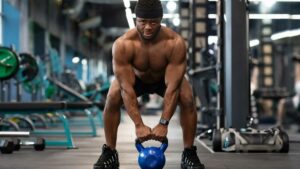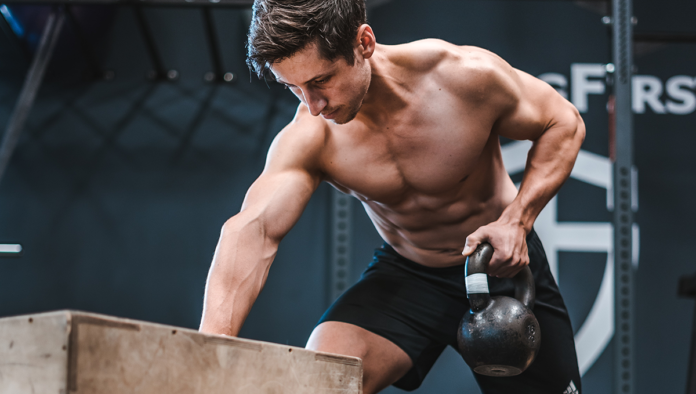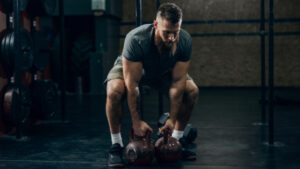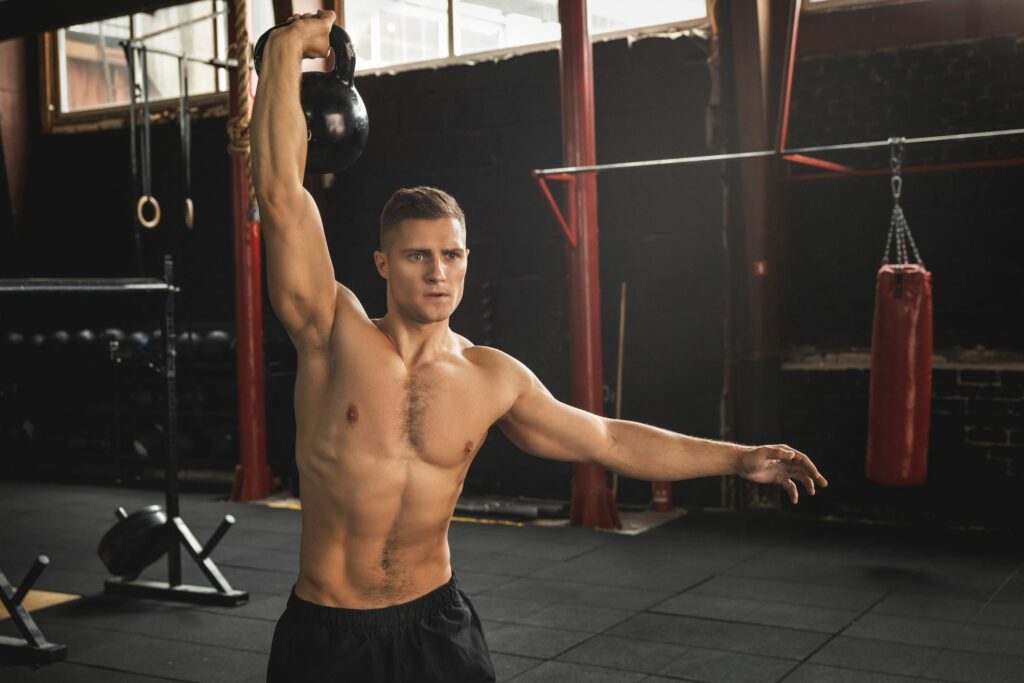KETTLEBELL BODYBUILDING: BUILDING MASS WITH KETTLEBELLS
Build muscle mass with the kettlebell ?
Gaining muscle mass is a key objective for many bodybuilding and fitness enthusiasts. The choice of tools is vast : dumbbells, barbells, etc.
In this article, we’ll try to explain why it’s possible to gain mass withkettlebell training. We’ll also show you the 26 best kettlebell exercises for the upper and lower body, as well as examples of programs you can do at home.
Can you build muscle mass with kettlebell training?
Muscle hypertrophy, or muscle growth, is the development of muscle cell mass, density, shape and function. In practical terms, this means increasing the volume of existing muscle fibers.
To create hypertrophy, there are several factors to consider :
- Mechanical tension: Mechanical or intramuscular tension is the effort applied to muscles during exercise. It is proportional to the load lifted.
- Time under tension : This is the time spent applying intramuscular tension.
These two parameters must be manipulated to create metabolic stress and muscle damage. Metabolic stress corresponds to the physiological stress suffered by muscle cells during exercise, and is proportional to the volume of training. Muscle damage corresponds to tissue damage. The body reacts to this metabolic stress and muscular damage by strengthening the muscles to adapt them to the efforts required, i.e. by creating muscle mass.
To create hypertrophy, you need to work with high mechanical tension (training load) and high time under tension (training volume). After a few sessions, once the muscles have adapted, you need to increase the tension, the volume, or both. This is the notion of progressive overload.
As you can see, the type of weight used (Olympic bar, dumbbells, bodyweight, etc.) is of little importance for hypertrophy, as long as it can be increased on a regular basis, and the load and volume are sufficient. A weight is a weight, so it’s perfectly possible to build muscle mass with kettlebells.

26 best kettlebell exercises
In this section, we present 26 kettlebell exercises for upper and lower body strength training.
Best kettlebell upper body exercises
Exercises with kettlebells for upper-body strength training are more or less the same as those with dumbbells. They effectively develop pectorals, back, shoulders, biceps, triceps, trapezius, forearms and abdominals.
Back kettlebell exercises
Thanks to their shape and grip, kettlebells are particularly well-suited to building back muscle mass. They are mainly used to perform horizontal pulling exercises, with one or two hands, to develop the thickness of the greater dorsalis, as well as the greater rectus and lower trapezius. Here are 3 highly effective kettlebell exercises for the back.
Lumberjack row :
Tilt your torso at about 45 degrees while supporting yourself with one hand on a stable object (bench, ledge, etc.). Take the kettlebell in the other hand and bring it down to pelvic level. This exercise is a unilateral horizontal pull.
Kettlebells row :
With a kettlebell in each hand, incline your torso at about 45 degrees while bending your knees slightly. Pull the kettlebells up to your pelvis. This is also a horizontal print, but on both sides.
Gorilla row :
The gorilla row is a very popular unilateral kettlebell pulling exercise. Two kettlebells are placed on the floor between your legs. Tilt your torso and grasp both kettlebells. Bring one kettlebell up to hip level with a slight rotation of the torso, while resting your other hand on the kettlebell on the floor.
Kettlebell pectoral exercises
Most classic pectoral exercises can be performed with kettlebells. Here are the main ones.
Kettlebell bench press :
Lie on a weight bench, arms stretched out over your chest with a kettlebell in each hand. Lower the kettlebells to the level of your pectoral muscles, then push them back up. The bench press is one of the most popular exercises in the world of bodybuilding for developing pectoral muscles.
Floor press :
This is the same exercise as the bench press, but performed lying on the floor rather than on a bench. The difference lies in the fact that the range of motion is smaller, since the elbows touch the ground. This exercise is better suited to the use of kettlebells than the classic bench press.
Kettlebell spreads :
Lying on the floor or on a bench, take a kettlebell in each hand and lower your arms perpendicular to your trunk, then bring them back. As you descend, you can flex your elbows slightly. This exercise is particularly recommended for isolating the pectoral muscles.
Shoulder and trapezius kettlebell exercises
With kettlebells, you can effectively increase the muscle mass of your shoulders and trapezius, thanks to pushing and pulling movements.
Kettlebell Military press :
A vertical thrust exercise par excellence, the kettlebell military press will help you develop impressive shoulders. Standing with a kettlebell in each hand, place yourself in the rack position (kettlebells on your shoulders). Stretch your arms above your head, then bring them back.
Kettlebell chin-up row:
Standing, grasp a kettlebell with both hands and pull the elbows up to the chin. This exercise is effective for developing the lateral and posterior parts of the shoulder.
Kettlebell Frontal raises :
Standing, grasp a kettlebell with both hands by the sides of the handle and bring it down to face level while keeping your arms straight. This exercise effectively develops the front part of your shoulders.
Kettlebell Shrug :
Standing with a kettlebell in each hand, raise your shoulders, keeping your arms straight. The shrug is recommended for building trapezius muscles.
Biceps kettlebell exercises
Kettlebell hammer curl :
Standing, grasp a kettlebell with both hands by the sides of the handle and flex your elbows to bring the kettlebell down to chest level. The neutral grip of the hammer curl effectively develops the thickness of your arms.
Curl kettlebell :
Standing with a kettlebell in each hand in supinated grip, flex your elbows, bringing the kettlebells up to chest level. This exercise can also be performed unilaterally, one arm at a time.
Kettlebell triceps exercises
Triceps kettlebell extension :
Standing, grasp a kettlebell with both hands in an inverted grip by the sides of the handle. Stretch your arms above your head, then flex your elbows as you bring the kettlebell behind your head.
Skull crusher kettlebell :
Lying on the floor or on a bench, with your arms stretched above your chest and a kettlebell, bend your elbows, bringing the kettlebell up to your forehead.
Forearm kettlebell exercises
Most kettlebell exercises already place heavy demands on the forearms. However, there are specific exercises that will enable you to accentuate the development of this often neglected part of the body.
Radial deviation kettlebell :
With your forearms resting on the floor, grasp an upside-down kettlebell with both hands by the sides of the handle and lift it up without lifting your forearms off the floor.
Pronation/supination kettlebell :
In the same position as the previous exercise, grasp the kettlebell with one hand and lift it, rotating your forearm in one direction and then the other.
Kettlebell abs exercises
Here again, most kettlebell exercises place a heavy load on the abdominal muscles. But certain exercises can help you target the abdominal muscles more optimally.
Sit-up kettlebell :
Lying on the floor, bring your feet towards you by bending your legs. Grab a kettlebell and place it on your torso. Flex your trunk.
Russian twist kettlebell :
Sitting on the floor, legs bent, grab a kettlebell with both hands. Rotate your torso, touching the ground on one side and then the other.
Lateral kettlebell bending :
Standing with a kettlebell in one hand, bend your torso sideways, then switch sides.

Best kettlebell lower body exercises
Leg muscles are the largest in the human body, so they’re the ones you can rely on to build muscle mass. Exercises using kettlebells to build lower-body strength are more or less the same as those using dumbbells. They effectively develop the glutes, quadriceps, hamstrings and calves.
Kettlebell exercises for glutes and hamstrings
The most effective movements for developing the glutes and hamstrings are hip extension movements with the legs straight or almost straight.
Swing kettlebell :
The king of kettlebell exercises ! The swing is a formidable hip-extension exercise that effectively develops your glutes and hamstrings. This is a ballistic movement. Grab a kettlebell with both hands and throw it up to chest level with the power of your hips, then let it return between your thighs.
Deadlift kettlebells :
This exercise is performed with two kettlebells, placed on the outside of your feet. Grab a kettlebell in each hand and stand up.
Deadlift straight legs kettlebell :
Stand and grasp a kettlebell with both hands. Tilt your torso forward while keeping your legs almost straight (slight bending of the knees) to bring the kettlebell under your knees.
Kettlebell exercises for buttocks and quadriceps
To develop the quadriceps, you need to perform movements with significant knee flexion.
Front squat kettlebells :
Standing with a kettlebell in each hand, place yourself in the rack position (kettlebells on your shoulders). Bend your legs, keeping your torso as upright as possible and contracting your abdominal muscles.
Goblet squat kettlebell :
Standing, grasp a kettlebell with both hands by the sides of the handle and bend your elbows to bring it to your chest. In this position, perform squats.
Kettlebell lunge :
Lunges can be performed with two kettlebells or a single kettlebell. Whatever the variant, the idea is to take a step forward, then bend the leg until the knee of the rear leg touches the ground, then come back up.
Kettlebell calf exercises
An often neglected part of the body, the calves are nonetheless important for developing muscular, harmonious legs. Here’s an exercise to build up your calves.
Calf extension kettlebell :
Standing, grasp a kettlebell in one hand. Stand on one leg, then perform ankle extensions.

Kettlebell training program
Full Body minimalist kettlebell program (3 days of training per week)
Here’s a minimalist kettlebell bodybuilding program. This program comprises 3 sessions per week, with 3 exercises per session : a leg exercise, a push exercise and a pull exercise. There are two standard sessions : session A and session B. In the first week, you’ll do the sessions in this order : A-B-A, and in the second week in this order : B-A-B.
For example, the first week : Monday session A, Wednesday session B and Friday session A. The following week : Monday session B, Wednesday session A and Friday session B. Then you continue to alternate weeks in this way.
Each session consists of just 3 exercises, making this program ideal if you only have a short time to train (45min per session).
Session A :
Front Squat 3 sets of 12 repetitions
Floor Press 3 sets of 10 repetitions
Gorilla Row 3 sets of 10 repetitions
Session B :
Deadlift 3 sets of 12 repetitions
Military bench press 3 sets of 10 repetitions
Rowing 3 sets of 10 repetitions
Full Body kettlebell program (3 days of training per week)
This program is composed in the same way as the previous : two standard sessions (A and B). A-B-A sessions the first week, then B-A-B sessions the following week. However, it includes more exercises and therefore allows for more complete muscle development. If you have 1h-1h30 to devote per session, this program is the ideal choice.
Session A :
Front Squat 3 sets of 12 repetitions
Floor Press 3 sets of 10 repetitions
Gorilla Row 3 sets of 10 repetitions
Calf extension 3 sets of 15 repetitions
Triceps extension 3 sets of 8 repetitions
Session B :
Deadlift 3 sets of 12 repetitions
Military bench press 3 sets of 10 repetitions
Rowing 3 sets of 10 repetitions
Calf extension 3 sets of 15 repetitions
Hammer curl 3 sets of 8 repetitions
Half Body kettlebell program (4 days of training per week)
This program contains 4 workouts per week : 2 lower-body workouts and 2 upper-body workouts.
Monday session Low, Tuesday session High, Thursday session Low, Friday session High.
Lower body session :
Front Squat 3 sets of 8 repetitions
Lunge 3 sets of 10 repetitions
Deadlift 3 sets of 8 repetitions
Deadlift Stretch Legs 3 sets of 12 repetitions
Calves 3 sets of 15 repetitions
Upper body session :
Bench press 3 sets of 8 repetitions
Military bench press 3 sets of 10 repetitions
Rowing 3 sets of 8 repetitions
Hammer curl 3 sets of 12 repetitions
Triceps extension 3 sets of 12 repetitions
Push-Pull-Legs kettlebell program (3 training days per week)
This program contains 3 sessions per week : 1 upper body push session, 1 upper body pull session and 1 leg session.
Push session :
Bench press 3 sets of 8 repetitions
Military bench press 3 sets of 10 repetitions
3 sets of 12 repetitions
Skull Crusher 3 sets of 10 repetitions
Sit Up 3 sets of 12 repetitions
Pullover session :
Rowing 3 sets of 8 repetitions
Lumberjack pull 3 sets of 10 repetitions
Shrug 3 sets of 12 repetitions
Hammer curl 3 sets of 10 repetitions
Radial deviation 3 sets of 12 repetitions
Legacy session :
Front Squat 3 sets of 8 repetitions
Deadlift 3 sets of 8 repetitions
Lunge 3 sets of 12 repetitions
Deadlift Stretch Legs 3 sets of 12 repetitions
Calves 3 sets of 15 repetitions
Other articles that might interest you:
- MMA physical preparation with kettlebell
- Tennis physical preparation with kettlebell
- Military training with kettlebell
- GPP for running with kettlebell
- Kettlebell exercise for abs
- CrossFit kettlebell WOD
- Kettlebell exercises for women
- Kettlebell HIIT
- Kettlebell sport : all you need to know
- Skiing physical preparation with kettlebell
- Handball physical preparation with kettlebell
- Basketball physical preparation with kettlebell
- Rugby physical preparation with kettlebell
- Football physical preparation with kettlebell

